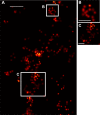Nanoscale imaging of caveolin-1 membrane domains in vivo
- PMID: 25646724
- PMCID: PMC4315472
- DOI: 10.1371/journal.pone.0117225
Nanoscale imaging of caveolin-1 membrane domains in vivo
Abstract
Light microscopy enables noninvasive imaging of fluorescent species in biological specimens, but resolution is generally limited by diffraction to ~200-250 nm. Many biological processes occur on smaller length scales, highlighting the importance of techniques that can image below the diffraction limit and provide valuable single-molecule information. In recent years, imaging techniques have been developed which can achieve resolution below the diffraction limit. Utilizing one such technique, fluorescence photoactivation localization microscopy (FPALM), we demonstrated its ability to construct super-resolution images from single molecules in a living zebrafish embryo, expanding the realm of previous super-resolution imaging to a living vertebrate organism. We imaged caveolin-1 in vivo, in living zebrafish embryos. Our results demonstrate the successful image acquisition of super-resolution images in a living vertebrate organism, opening several opportunities to answer more dynamic biological questions in vivo at the previously inaccessible nanoscale.
Conflict of interest statement
Figures





References
-
- Betzig E, Patterson GH, Sougrat R, Lindwasser OW, Olenych S, et al. (2006) Imaging intracellular fluorescent proteins at nanometer resolution. Science 313: 1642–1645. - PubMed
-
- Hell SW, Wichmann J (1994) Breaking the diffraction resolution limit by stimulated emission: stimulated-emission-depletion fluorescence microscopy. Opt Lett 19: 780–782. - PubMed
Publication types
MeSH terms
Substances
Grants and funding
LinkOut - more resources
Full Text Sources
Other Literature Sources
Molecular Biology Databases

